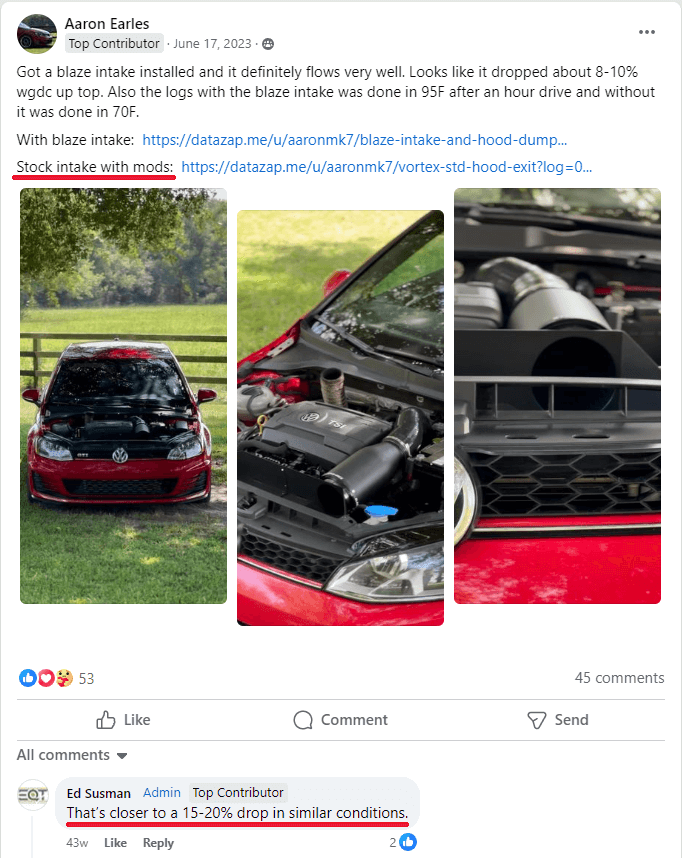Background:
After reading a person’s testimonial about the Blaze intake excelling based on user experiences I inquired about the purported results showing it was superior to other intakes.
The person provided three examples of information they had based their opinion on. One of the examples I have previously addressed is Matt Ferreira’s (EQT) erroneous evaluation of a Racingline R600 intake with APR turbo inlet elbow.
Another was a link to the EQT web store product description for the Blaze intake. There, EQT has selected three mystery intakes to make a comparison with, providing no useful information.
The other link was to information I had seen from a user but had previously not addressed.
Got a Blaze intake installed and it definitely flows very well.
Aaron Earles – Vortex hybrid turbo user
Setup overview:
In the person’s post describing their experience with the Blaze ATOM V2 intake and follow-on conversation, we learned that they were initially using a stock airbox with a K&N air filter, the snow grate removed, and a CTS Turbo inlet elbow with their Vortex (hybrid turbo) equipped GTI.

CTS Turbo does not hide the fact that its inlet elbow is made for a stock turbocharger:

Intake Comparison:
Despite being made for a stock turbocharger the person went ahead and installed the CTS elbow on their larger Vortex turbo.
Note: The image below shows how much of the hybrid turbocharger inlet cross-section is blocked off from allowing airflow when using a stock-size inlet elbow.

This person used a TIP with an outlet diameter of 51.3 mm and attached it to a turbo with a 56 mm inlet.
In addition to being a mismatch for the turbo, the CTS TIP has been flow-tested and produced the second-lowest flow rate of all aftermarket inlet elbows that have been tested.
Later, they switched to the Blaze ATOM V2 intake which uses a turbo inlet attachment that has a 55.7 mm diameter, and found that the turbocharger wastegate duty cycle decreased.
They then concluded that the Blaze ATOM V2 intake flows very well, along with getting confirmation from EQT owner Ed Susman (below post) who pointed out that under similar atmospheric conditions, the improvement would have been greater.
Ed doesn’t point out that with an appropriate inlet elbow for the person’s turbocharger, the difference in results between the Blaze intake and modified stock intake would have been much less.

Conclusions:
A purchaser of the Blaze ATOM V2 intake erroneously concludes the source of a wastegate duty cycle change on their vehicle to be a result of their choice of intake, overlooking the significant effect the choice of turbo inlet elbow has on the airflow rate.
The owner of Equilibrium Tuning fails to educate the consumer on the true source of the difference and instead tacitly reinforces the misunderstanding that the intake produced the improvement by suggesting the difference would be greater under similar operating conditions.
This is the fifth example of a Blaze Performance intake comparison of “user results speak for themselves” where the user caused a parts mismatch between the turbo inlet elbow and the turbo compressor inlet.
As of the time of this post, I have not seen evidence showing the Blaze Performance ATOM Race V2 intake outperforming other aftermarket intakes when alternative intakes are paired with an appropriate turbo inlet elbow for the turbocharger being used.
